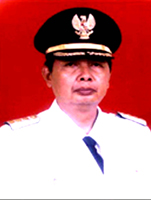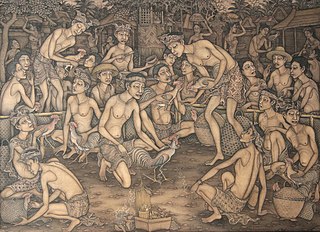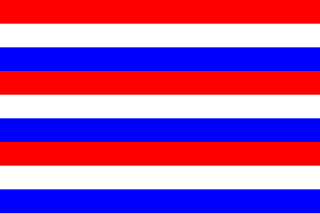Related Research Articles
Anak Agung Pandji Tisna, also known as Anak Agung Nyoman Pandji Tisna, I Gusti Nyoman Pandji Tisna, or just Pandji Tisna, was the 11th descendant of the Pandji Sakti dynasty of Buleleng, Singaraja, which is in the northern part of Bali, Indonesia. He succeeded his father, Anak Agung Putu Djelantik, in 1944.

Buleleng is a regency of Bali Province, Indonesia. It stretches along the north side of the island of Bali from the Bali Strait in the west almost to the eastern end of the island. It has an area of 1,365.88 km2 and population of 624,125 at the 2010 census and 791,910 at the 2020 census; the official estimate as at mid 2022 was 825,141. Its regency seat is at the town of Singaraja.
A Balinese name is part of a system of identification used by the Balinese people and in the western parts of the neighboring island of Lombok, Indonesia. A Balinese name will have three parts: a title, a birth order name and a personal name. Balinese people do not use a family name.

Anak Agung Ngurah Oka Ratmadi, commonly known as Cok Rat, was the regent of Badung Regency, Bali, Indonesia from 1999 to 2005, and currently a member of the Regional Representative Council (DPD) from Bali since 2014. He was nominated for the Governor of Bali in 2003, but he withdrew. He is the great-grandson of I Gusti Ngurah Made Agung, a National Hero of Indonesia who fought against the Dutch. He has three children, the second one, AA Krisna Yoga, died on 7 March 2016.

Balinese art is art of Hindu-Javanese origin that grew from the work of artisans of the Majapahit Kingdom, with their expansion to Bali in the late 14th century. From the sixteenth until the twentieth centuries, the village of Kamasan, Klungkung, was the centre of classical Balinese art. During the first part of the twentieth century, new varieties of Balinese art developed. Since the late twentieth century, Ubud and its neighboring villages established a reputation as the center of Balinese art.
I Nyoman Renbang (1937–2001) was an Indonesian musician, composer, teacher and instrument maker. He is considered by many ethnomusicologists as one of the most influential Balinese musicians and composers of the twentieth century.

The Klungkung Palace, officially Puri Agung Semarapura, is a historical building complex situated in Semarapura, the capital of the Klungkung Regency (kabupaten) on Bali, Indonesia. The palace (puri) was erected at the end of the 17th century, but largely destroyed during the Dutch colonial conquest in 1908. Today the basic remains of the palace are the court of justice, the Kertha Gosa Pavilion, and the main gate that bears the date Saka 1622. Within the old palace compound is also a floating pavilion, the Bale Kembang. The descendants of the rajas that once ruled Klungkung today live in Puri Agung, a residence to the west of the old palace, which was built after 1929.

Puputan is a Balinese term for a mass ritual suicide in preference to facing the humiliation of surrender. It originally seems to have meant a last desperate attack against a numerically superior enemy. Notable puputans in the history of Bali occurred in 1906 and 1908, when the Balinese were being subjugated by the Dutch.

The Dutch conquest of South Bali in 1906 was a Dutch military intervention in Bali as part of the Dutch colonial conquest of the Indonesian islands, killing an estimated 1,000 people. It was part of the final takeover of the Netherlands East-Indies. The campaign led to the deaths of the Balinese rulers of Badung and Tabanan kingdoms, their wives and children and followers. This conquest weakened the remaining independent kingdoms of Klungkung and Bangli, leading to their invasion two years later. It was the sixth Dutch military intervention in Bali.

Dalem Segening was a king of Bali who reigned in the first half of the 17th century, his exact dating being still uncertain. He belonged to a dynasty which originated from Majapahit on Java, and ruled from the palace (puri) of Gelgel.

Dalem Di Made was a king of Bali who may have reigned in the period 1623–1642. He belonged to a dynasty that claimed descent from the Majapahit Empire of Java, and kept residence in Gelgel, close to Bali's south coast.

The Dutch intervention in Bali in 1849 was a major Dutch military intervention in Northern and Southern Bali, following two failed interventions, the 1846 intervention and the 1848 intervention. The Dutch used as a pretext Balinese salvage claims over shipwrecks, which were customary to the Balinese, but unacceptable under International law.
Balinese literature refers to the oral and written Balinese language literature of the people of Bali, an island in Indonesia. It is generally divided into two periods: purwa, or traditional; and anyar, or modern.
Nemoe Karma is a 1931 novel by I Wayan Gobiah. It is the first Balinese language novel.

I Gusti Ketut Pudja was an Indonesian politician and national hero, who served as the first governor of Lesser Sunda from 1945 until 1946. He was a member of the Investigating Agency for Preparatory Work for Indonesian Independence (BPUPK). He was also present at Admiral Tadashi Maeda's house, during the preparation for the Proclamation of Indonesian Independence on 17 August 1945. Making him the only Balinese to be present during the proclamation.

The Kingdomship of Bali was a series of Hindu-Buddhist kingdoms that once ruled some parts of the volcanic island of Bali, in Lesser Sunda Islands, Indonesia. With a history of native Balinese kingship spanning from the early 10th to early 20th centuries, Balinese kingdoms demonstrated sophisticated Balinese court culture where native elements of spirit and ancestral reverence combined with Hindu influences – adopted from India through ancient Java intermediary – flourished, enriched and shaped Balinese culture.

I Gusti Bagus Oka was the Governor for the Province of Bali and Vice-Governor for the Province of Lesser Sunda. He and his wife, Gedong Bagus Oka, were the founding members of the Parisada Hindu Dharma Indonesia. I Gusti Bagus Oka was also the first Vice-chair of Parisada Hindu Dharma Indonesia. Throughout his public service career, I Gusti Bagus Oka held various government offices, while Gedong Bagus Oka served as Member of Parliament. The couple were also actively involved in social activity and founded Ashram Gandhi in Candidasa, Bali.
The Paruman Agung was the regional parliament of Bali from 1938 until 1950.
References
- Footnotes
- ↑ Putra 2010, p. 18.
- 1 2 Putra 2010, p. 19.
- 1 2 3 Putra 2010, p. 20.
- ↑ Suardiana 2012, p. 31.
- 1 2 3 Putra 2010, p. 21.
- ↑ Bagus & Ginarsa 1978, p. ii.
- 1 2 3 Putra 2010, p. 22.
- ↑ Marrison 1987, p. 21.
- Bibliography
- Bagus, I Gusti Ngurah; Ginarsa, I Ketut (1978). Kembang Rampé Kasusastran Bali Purwa[Outline of Old Balinese Literature] (in Balinese). Singaraja: Language Research Centre. OCLC 68577534.
- Marrison, G. (1987). "Modern Balinese — A regional literature of Indonesia". Bijdragen tot de Taal-, Land- en Volkenkunde. Leiden. 143 (4): 468–498. doi: 10.1163/22134379-90003315 .[ permanent dead link ]
- Putra, I Nyoman Darma (2010). Tonggak Baru Sastra Bali Modern[A New Milestone in Modern Balinese Literature] (in Indonesian) (2nd ed.). Denpasar: Pustaka Larasan. ISBN 978-979-3790-51-0.
- Suardiana, I Wayan (February 2012). "Kesusastraan Bali dalam Menjawab Tantangan Global" [Balinese Literature, Addressing Global Issues]. Jurnal IKADBUDI (in Indonesian). Yogyakarta: IKADBUDI. 1 (1).